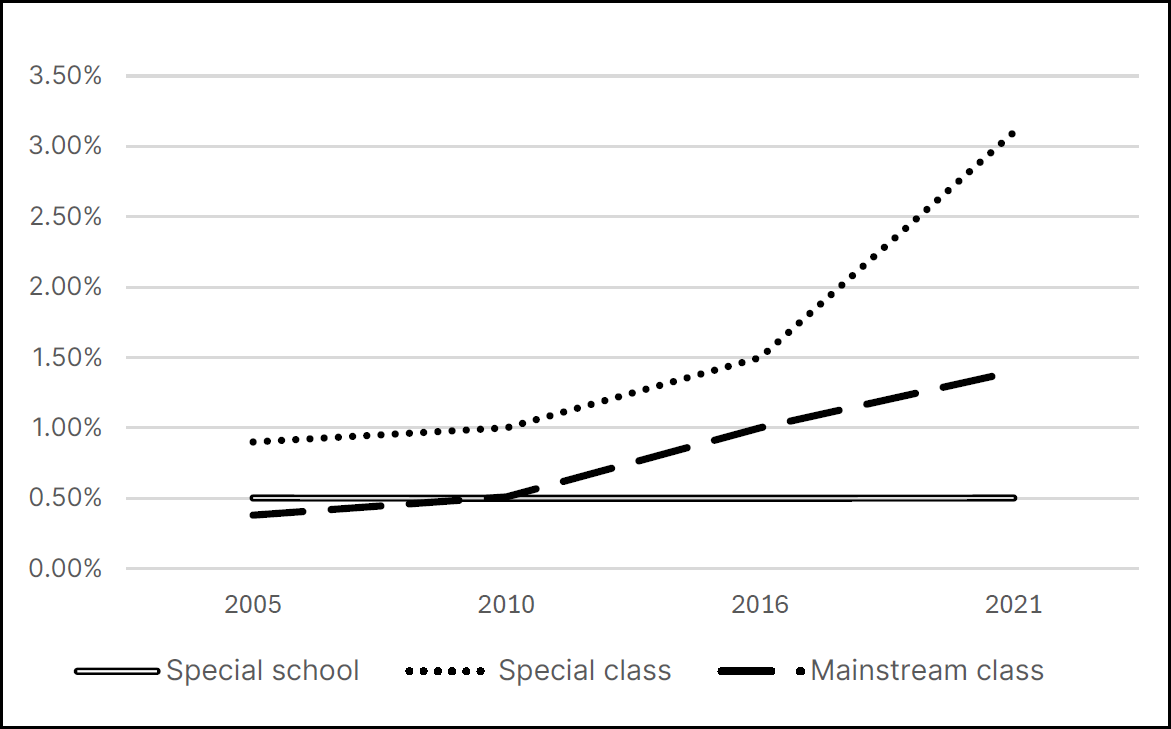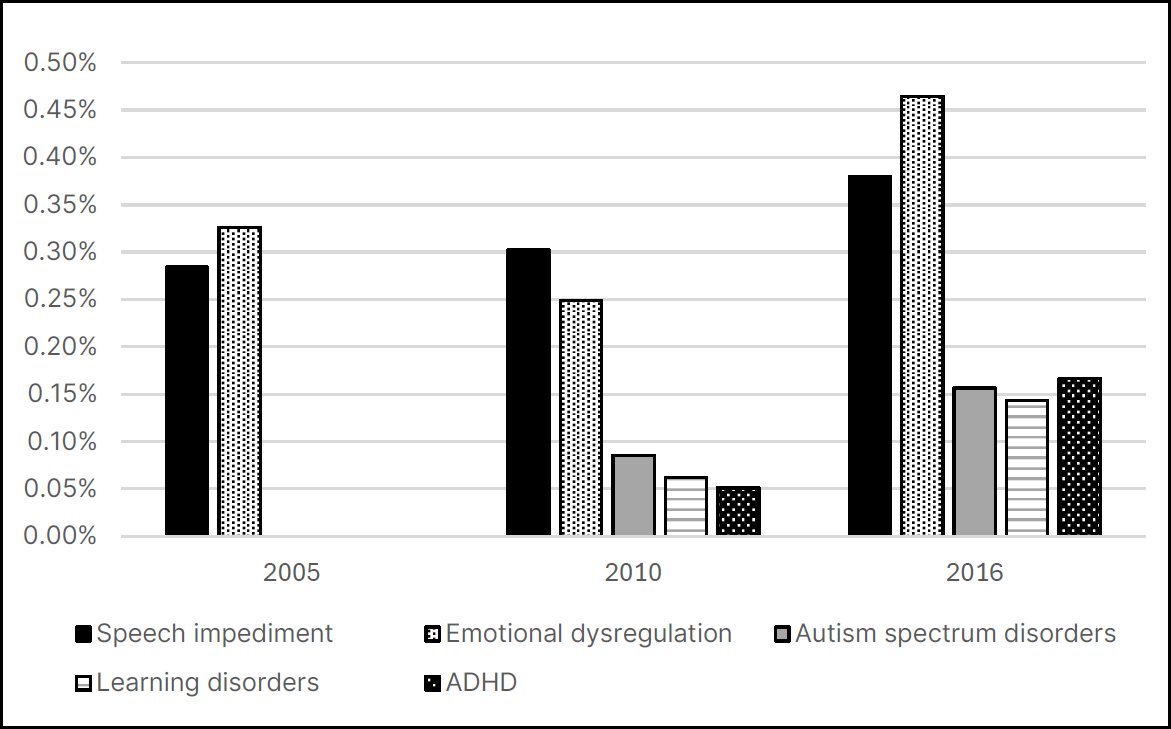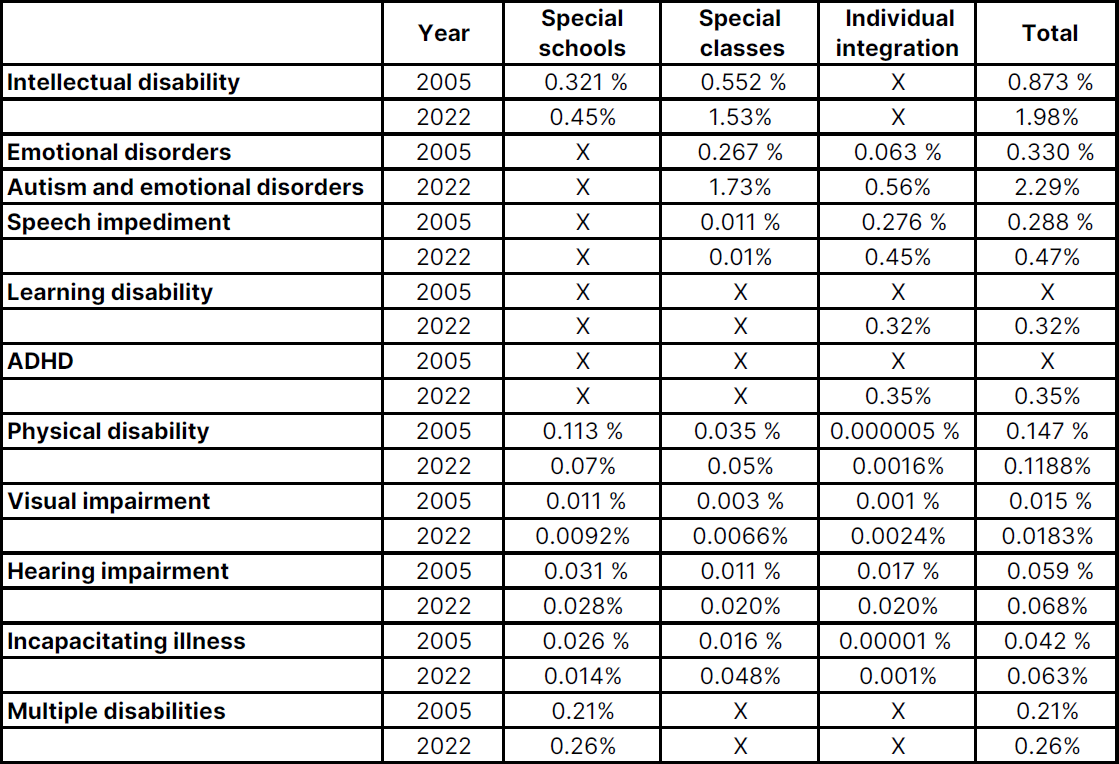
Disability & Education in Japan
Save PDFLesson Plan: Disability & Education in Japan
Created by: Anne-Lise Mithout, Université Paris Cité
Creation date: February 16, 2024
Keywords: Disability, Education, Special Needs, Inclusion, Special School
Disability & Education in Japan
Target Audience:
Undergraduate students, Graduate students
Duration:
1 or 2 class sessions
Learning Objectives:
This lesson aims to explore the situation of children with disabilities in the Japanese education system. It encourages students to compare the different enrollment options available to disabled students (mainstream class, special class in a mainstream school, special school), their benefits and their limits.
It provides an overview of the repartition of students between the three structures and can serve as a base for a methodological discussion on the use of public statistics and quantitative data for sociological research.
It also aims to provide a qualitative perspective on the specificities of each system. The teacher can choose to focus either on special schools or on inclusive education, or to tackle both.
Potential Courses to Include this Lesson in:
Japanese, Asian, or global education studies
Japanese, Asian or global disability studies
Any course that focuses explicitly on disability
Required Materials:
Data Tables (see below)
Potential Readings:
On inclusive education in Japan:
FORLIN, Chris, KAWAI, Norimune, HIGUCHI, Satoshi. Educational reform in Japan towards inclusion: Are we training teachers for success?. International Journal of Inclusive Education, 2015, vol. 19, no 3, p. 314-331.
MCGUIRE, Jennifer, TOKUNAGA, Tomoko. Co-constructing belonging:‘Voluntary separation’ in deaf and immigrant education in Japan. Japanese Studies, 2020, vol. 40, no 3, p. 291-311.
MITHOUT, Anne-Lise. Children with disabilities in the Japanese school system: a path toward social integration?. Contemporary Japan, 2016, vol. 28, no 2, p. 165-184.
YOSHITOSHI, Munehisa, TAKAHASHI, Kiriko. A critical analysis of court decision on mainstream school attendance of a child with medical care needs in Japan: a long way towards inclusive education. International Journal of Inclusive Education, 2023, vol. 27, no 11, p. 1257-1271.
On special schools in Japan:
KAYAMA, Misa, and Wendy L. HAIGHT. Disability, Culture, and Development: A Case Study of Japanese Children at School. Oxford University Press, 2014.
MITHOUT, Anne-Lise. The transformations of Special Schools for the Blind in times of inclusion: A French-Japanese perspective. Ars Vivendi Journal, 2017, no 8/9, p. 34-55.
MIYAUCHI, Hisae. A study of outreach projects in schools for the blind in Japan. In : International Congress Series. Elsevier, 2005. p. 890-893.
MIYAUCHI, Hisae et MATSUDA, Erika. Role of Japanese schools for the blind in the era of inclusion. British Journal of Visual Impairment, 2022, p. 02646196221124429.
On the construction of the category “Hattatsu shōgai”:
TERUYAMA, Junko. Japan’s New Minority: Persons with Hattatsu Shogai (Developmental Disability). 2014. Doctoral dissertation. University of Michigan.
A few suggestions of general readings about special needs education in a non-Japanese context:
FLORIAN, Lani et SPRATT, Jennifer. Enacting inclusion: A framework for interrogating inclusive practice. European Journal of Special Needs Education, 2013, vol. 28, no 2, p. 119-135.
SHAW, Anne. Inclusion: the role of special and mainstream schools. British Journal of Special Education, 2017, vol. 44, no 3, p. 292-312.
WARNOCK, Mary et NORWICH, Brahm. Special educational needs: A new look. Bloomsbury Publishing, 2010.
Discussion Questions:
What do you think are the main differences between studying in a special school and studying in a mainstream school, for a disabled child? What are the benefits and the limits of both systems? What do you think of the system called “special classes” in mainstream schools?
The Japanese education system was reformed in 2006 to promote inclusion of children with disabilities in mainstream schools. What kind of data do we need to assess whether this reform was a success? How can we gather such data?
Based on data provided in table 1 (see annex), would you say that the reform has allowed more children to attend mainstream schools rather than special schools ? Why ?
How would you explain the rise in the total number of disabled children that has occurred since 2006 ? What kind of data would you need to prove your hypothesis ?
How do you interpret data provided in tables 2, 3 and 4 (see annex) ?
Focusing on special schools : why do you think special schools still exist in the era of inclusion ? What kind of evolution do they face ?
Focusing on mainstream schools : what kind of challenges do they face with the increase of the number of disabled students ? How does the presence of a disabled students in the classroom affect teachers’ work ? Does the presence of a disabled student in a class impact the group dynamics among students ? What kind of support systems can be developed to make schools more inclusive ?
Relevant Vocabulary:
Here is a great general guide for best practices in disability-related language by the Center for Disability Rights.
Background Information for Instructors:
More information about the Japanese special needs education system can be found on the website of the Ministry of Education, Sports, Science and Technology (MEXT) :
Special needs education (in English)
Statistical data (Japanese only)
More detailed reports on the situation of students with different types of impairments can be found on the website of the National Institute of Special Needs Education (NISE) (mainly in Japanese).
Papers on inclusive education in various countries can be found in the International Journal of Inclusive Education.
Data Tables:
 Table 1: Evolution of the number of disabled students by type of school/class as a proportion of the total school population. Based on MEXT data.
Table 1: Evolution of the number of disabled students by type of school/class as a proportion of the total school population. Based on MEXT data.
 Table 2: Evolution of the number of disabled students by category of impairment. Based on MEXT data.
Table 2: Evolution of the number of disabled students by category of impairment. Based on MEXT data.
 Table 3: Situations included in the category “Hattatsu shōgai” (2015-2016). Based on MEXT data.
Table 3: Situations included in the category “Hattatsu shōgai” (2015-2016). Based on MEXT data.
 Table 4: Evolution of headcounts in the three schooling structures for children with disabilities – according to type of disability (2005–2022). Based on MEXT data.
Table 4: Evolution of headcounts in the three schooling structures for children with disabilities – according to type of disability (2005–2022). Based on MEXT data.
Note: The “X” sign means that children with that type of disability cannot be enrolled in the corresponding schooling structure or that the category did not exist for the year concerned.